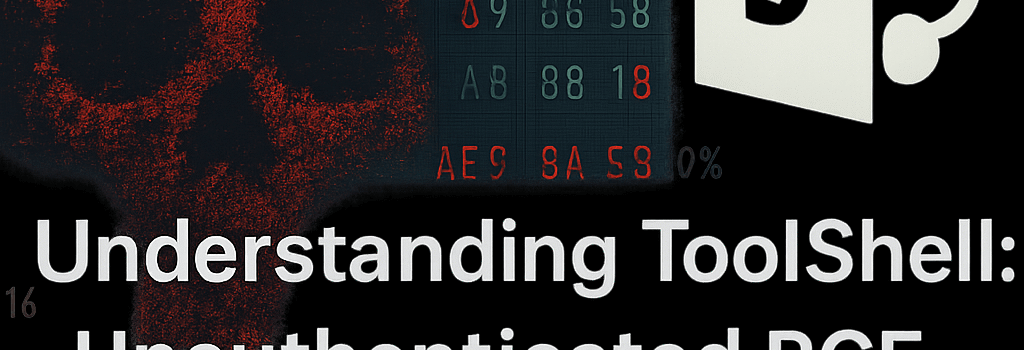Understanding ToolShell: Unauthenticated RCE Exploit in SharePoint

Updated Aug 2, 2025: Microsoft and CISA have issued expanded advisories, and Security firms like FireEye and CrowdStrike have released new IOCs and YARA rules to detect the ToolShell intrusion. A patched .NET assembly hotfix is expected in the next Patch Tuesday.
Active Exploitation at Scale
Over the past two weeks, government agencies and private enterprises have been battling a severe server-side vulnerability in on-premises SharePoint deployments—collectively dubbed ToolShell. The unauthenticated remote code execution (RCE) flaw, tracked as CVE-2025-53770, is under mass exploitation, with hundreds of confirmed compromises worldwide.
What Is SharePoint?
SharePoint is an enterprise collaboration and content management platform, built on Microsoft’s IIS and .NET frameworks. Deployed since 2001, it provides document libraries, lists, and web parts across intranets. As of 2024, Microsoft reported over 400,000 customer organizations—80% of the Fortune 500—running on-premises SharePoint instances. The server architecture uses ToolPane.aspx to render UI side panels, which became the attack vector in this instance.
Vulnerability Overview: CVE-2025-53770
The core flaw is an insecure deserialization issue within the ToolPane.aspx handler. An unauthenticated attacker can:
- Upload a malicious ASPX webshell (e.g.,
spinstall0.aspx) via craftedPOSTrequests. - Retrieve the server’s
MachineKey(AES-CBC with HMAC-SHA256) via reflection and return decrypted values. - Generate valid ViewState payloads to bypass authentication and gain administrative privileges, even under MFA and SSO.
First spotted July 19 by Eye Security, the flaw carries a CVSS v3.1 score of 9.8. Microsoft’s telemetry confirms active exploitation began as early as July 7, making it a true zero-day.
Attribution: Who’s Behind ToolShell?
- Linen Typhoon: Known for IP theft, persisting in SharePoint as a beachhead.
- Violet Typhoon: Traditional espionage actors with .NET-based toolkits.
- Storm-2603: Linked to ransomware operations, newly profiled by Microsoft Threat Intelligence.
Additional private crime syndicates may also exploit the same vectors; CISA warns of likely copycats deploying customized webshells.
Why “ToolShell”?
The name originates from a Pwn2Own Berlin proof-of-concept by researcher Dinh Ho Anh (Viettel Cyber Security). The exploit abuses the ToolPane.aspx insecure deserialization chain, inserting webshells into SharePoint’s side panel renderer. Microsoft’s initial patches for CVE-2025-49704 and CVE-2025-49706 left residual code paths, enabling the current widespread RCE.
Deep Dive: Exploit Chain Mechanics
Detailed analysis by Akamai and SentinelOne reveals:
- Step 1: POST to
/_layouts/15/ToolPane.aspxwith a multipart/form-data payload containing a serialized .NET object. - Step 2: Insecure deserialization triggers reflection, calling
MachineKeySectionto expose decryption keys. - Step 3: Attacker sends GET requests to retrieve clear-text configuration and crafts a valid ViewState MAC.
- Step 4: Final payload runs
spinstallX.aspxwebshells, deploying additional Dropper modules and backdoors.
Advanced Detection and Indicators of Compromise (IOCs)
Security teams should hunt for:
- Unexpected
spinstall*.aspxfiles under/_layouts/15/. - POST requests with serialized binary data or high-entropy payloads to
ToolPane.aspx. - PowerShell or C# commands within webshell logs attempting
MachineKeyretrieval. - New administrative service accounts created via
SPUserobject manipulation.
CrowdStrike and FireEye have published YARA rules and Sigma signatures to automate detection in SIEMs such as Splunk and Azure Sentinel.
Mitigation Strategies and Best Practices
- Immediate Patching: Apply Microsoft’s emergency patch (KB5029381) and verify the absence of vulnerable assemblies via
Get-FileHash. - Network Segmentation: Isolate SharePoint servers from untrusted networks; enforce Web Application Firewall rules to block anomalous ToolPane requests.
- Runtime Hardening: Enable
ViewStateUserKey, disable ViewState MAC exceptions, and adopt Anti-Serialization libraries (e.g., Newtonsoft.Json with safe converters). - Monitoring & Logging: Forward IIS request logs and Windows Event IDs (e.g., 4688 process creations) to a central SIEM with correlation rules for ToolShell patterns.
- Periodic Red-Teaming: Simulate ToolShell-style exploit chains in a controlled environment using Cobalt Strike or Metasploit modules to validate defenses.
Future Outlook and Industry Response
Microsoft has committed to a deeper code audit of SharePoint’s API surface and plans to ship a .NET Framework 4.8.2 update with hardened BinaryFormatter protections. Meanwhile, CISA’s Emergency Directive 26-2 mandates U.S. federal agencies to confirm patch deployment by Aug 10, 2025.
“This incident underscores the importance of secure coding practices around deserialization,” says Dr. Emily Zhang, lead researcher at SANS Institute. “Organizations must treat deserialization attacks as a critical threat vector.”
What to Do If You Maintain On-Premises SharePoint
1. Verify all servers are patched to KB5029381. 2. Conduct a full forensic review using IOCs from Microsoft, CISA, and third-party advisories. 3. Reset all service and admin credentials, rotate MachineKeys, and enforce MFA on all accounts.
For detailed runbooks, see CISA’s Emergency Directive 26-2 and Microsoft’s ToolShell response guide.